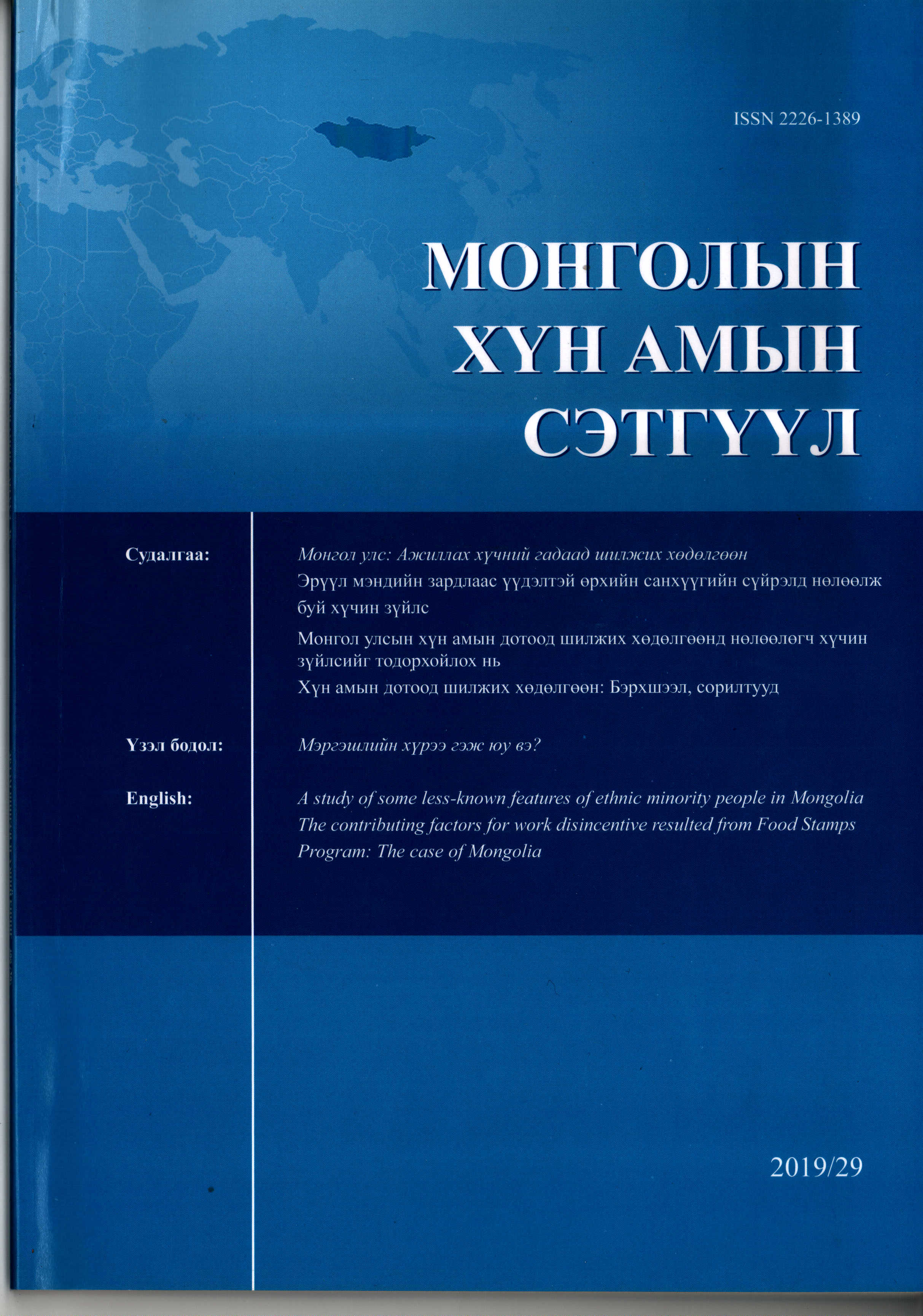A study of some less-known features of ethnic minority people in Mongolia
Main Article Content
Abstract
Энэ судалгаагаар Монголчуудын зонхилох үндэстэн (халх) болон угсаатны цөөнхийн нийгэм-эдийнзасгийн байдал, амьжиргааны түвшинг харьцуулан авч үзсэн. ҮСХ-ноос угсаатны цөөнх болон зонхилох үндэстний байршилт, тархалтыг харуулсан тооллогын нэгдсэн мэдээ баримтаас өөр мэдээлэл нарийн байхгүй учраас энэхүү судалгаанд зарим аймгуудыг хэсэгчлэн сонгож дүн шинжилгээг хийв.Судалгаанд угсаатны цөөнх харьцангуй төвлөрөн амьдардаг 3 аймаг (70%-90%), халх үндэстэн (99%) зонхилдог 4 аймгийг сонгосон болно. Мэдээллийн бэлэн байдлаас хамаарч ХАЗ, НЭЗ-ийн 14үзүүлэлтийг дүн шинжилгээнд ашиглав. Дүн шинжилгээгээр угсаатны цөөнх зонхилдог аймгуудыг гол үндэстэн зонхилж буй аймгуудтай харьцуулахад өрхийн хэмжээ, ам бүлийн тоо олон болох нь нотлогдсон. Хоёр бүлэгт хуваасан сонгосон аймгуудын хувьд өрхийн орлого, зарлага, ажилгүйдэл, хүний хөгжлийн индекс гэсэн 4 үзүүлэлтийн хувьд ялгаа байхгүй байна. Буриад угсаатныг халх үндэстэнтэй харьцуулахад эмзэг байдал бага, өрхийн орлогоор илүү, ахуйн цахилгаан хэрэгслийн хэрэглээ өндөр байна. Судалгаагаар угсаатны цөөнх болох казах, дөрвөд, баяд, захчин, урианхай угсаатны хувьд ХАЗ, НЭЗ-ийн 10 үзүүлэлтээр ялгаатай, харин 4 үзүүлэлтийн хувьд ялгаагүй гэсэн үр дүн гарсан. Судалгаанаас зонхилох үндэстэнтэй харьцуулсан угсаатны цөөнхүүдээр ангилсан задгай мэдээлэл цуглуулах, хүн амын олонх ба угсаатны цөөнхийн хооронд гарч байгаа амьжиргааны түвшний болон эдийн засгийн үзүүлэлтийн ялгааг тодруулах, учир шалтгааныг илүү тодруулах, алслагдсан бүс нутгуудад амьдарч буй угсаатны цөөнхийн амьжиргааны түвшинг дээшлүүлэхэд илүү анхаарах шаардлагатай болохыг зөвлөсөн.
This study compares the socio-economic and well-being of ethnic minority and the mainstream (Khalkh) people in Mongolia. The approach taken by the study is to extract provincial data base as there is no data (excluding distribution of ethnic group from census) reported for ethnic minority and the mainstream people by the NSO. The study has selected three provinces where ethnic minority people in the provincial population are high (between 70 to 99%) and four other provinces where 99% of the population compris-es of ethnic Khalkh people. Fourteen parameters where data is available have been made use of by the study. The analyses reveal that the household size in ethnic minority dominant provinces is higher than the non-dominant provinces. The ethnic minority people’s quality of life is inferior to the mainstream people by way of life expectancy, the proportion of economically active population and gender index while the former is better off by higher wage rate for both men and women and educational achievement. There is no difference between the two sets of provinces with regard to four parameters namely, household income, expenditure, unemployment and human development index. Ethnic Buriats are better off than Khalkh by way of lower vulnerability, higher household income and possession of more of electrical goods by the Buriat people. The results of the study conclude that ethnic minority people, mainly Kazakh, Durvud, Bayad, Zakchin and Uriankhai are different from the main stream population as far as 10 variables are considered whilst there is no difference with regard to four other variables. The study recommends the need for disaggregated data on ethnic minority vis-а-vis mainstream people, further research to explain differences in living standards and economic performance between the ethnic minority and the mainstream people as well as the need to pay greater attention for the improvement of living standards of ethnic minority people in remote provinces of Mongolia.
